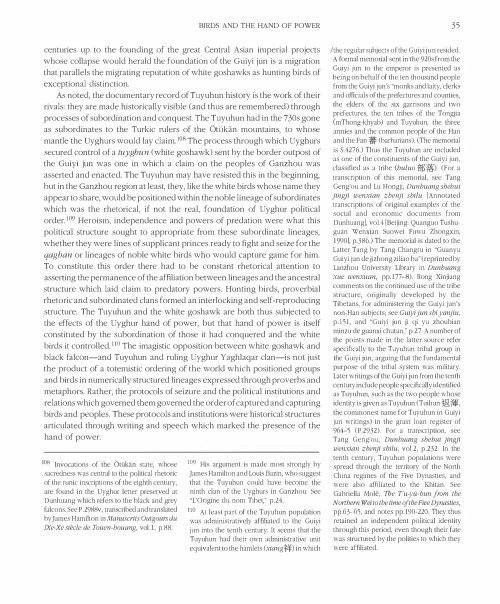East Asian History - ANU
East Asian History - ANU
East Asian History - ANU
- No tags were found...
You also want an ePaper? Increase the reach of your titles
YUMPU automatically turns print PDFs into web optimized ePapers that Google loves.
BIRDS AND THE HAND OF POWER35centuries up to the founding of the great Central <strong>Asian</strong> imperial projectswhose collapse would herald the foundation of the Guiyi jun is a migrationthat parallels the migrating reputation of white goshawks as hunting birds ofexceptional distinction.As noted, the documentary record of Tuyuhun histOlY is the work of theirrivals: they are made historically visible (and thus are remembered) throughprocesses of subordination and conquest. The Tuyuhun had in the 730s goneas subordinates to the Turkic mlers of the Oti.ikan mountains, to whosemantle the Uyghurs would lay claim. 108 The process through which Uyghurssecured control of a tuyghun (white goshawk) sent by the border outpost ofthe Guiyi jun was one in which a claim on the peoples of Ganzhou wasasserted and enacted. The Tuyuhun may have resisted this in the beginning,but in the Ganzhou region at least, they, like the white birds whose name theyappear to share, would be positioned within the noble lineage of subordinateswhich was the rhetorical, if not the real, foundation of Uyghur politicalorder.109 Heroism, independence and powers of predation were what thispolitical stmcture sought to appropriate from these subordinate lineages,whether they were lines of supplicant princes ready to fight and seize for theqaghan or lineages of noble white birds who would capture game for him.To constitute this order there had to be constant rhetorical attention toasserting the permanence of the affiliation between lineages and the ancestralstructure which laid claim to predatory powers. Hunting birds, proverbialrhetoric and subordinated clans formed an interlocking and self-reproducingstmcture. The Tuyuhun and the white goshawk are both thus subjected tothe effects of the Uyghur hand of power, but that hand of power is itselfconstituted by the subordination of those it had conquered and the whitebirds it controlled. no The imagistic opposition between white goshawk andblack falcon-and Tuyuhun and ruling Uyghur Yaghlaqar clan-is not justthe product of a totemistic ordering of the world which positioned groupsand birds in numerically stmctured lineages expressed through proverbs andmetaphors. Rather, the protocols of seizure and the political institutions andrelations which governed them governed the order of captured and capturingbirds and peoples. These protocols and institutions were historical structuresarticulated through writing and speech which marked the presence of thehand of power.108 Invocations of the Gtubn state, whosesacredness was central to the political rhetoricof the runic inscriptions of the eighth century,are found in the Uyghur letter preserved atDunhuang which refers to the black and greyfalcons. See P . 2988v , transcribed and translatedby James Hamilton in Manuscrits Ouigours du/Xe-Xe siecle de Touen-houang, vol.l, p.88.109 His argument is made most strongly byJames Hamilton and Louis Bazin, who suggestthat the Tuyuhun could have become theninth clan of the Uyghurs in Ganzhou. See"L'Origine du nom Tibet," p.24.110 At least part of the Tuyuhun populationwas administratively affiliated to the Guiyijun into the tenth century. It seems that theTuyuhun had their own administrative unitequivalent to the hamlets (xiang) in whichIthe regular subjects of the Guiyi jun resided.A formal memorial sent in the 920s from theGuiyi jun to the emperor is presented asbeing on behalf of the ten thousand peoplefrom the Guiyi jun's "monks and laity, clerksand officials of the prefectures and counties,the elders of the six garrisons and twoprefectures, the ten tribes of the TongjiaCmThong-khyab) and Tuyuhun, the threearmies and the common people of the Hanand the Fan ¥ (barbarians). (The memorialis 5.4276.) Thus the Tuyuhun are includedas one of the constituents of the Guiyi jun,classified as a tribe (buluo tffl) (For atranscription of this memorial, see TangGeng'ou and Lu Hongji, Dunhuang shehuijingji wenxian zhenji shilu [Annotatedtranscriptions of original examples of thesocial and economic documents fromDunhuangl, vol.4 [Beijing: Quanguo TushuguanWenxian Suowei Fuwu Zhongxin,1990], p.386.) The memorial is dated to theLatter Tang by Tang Changru in "GuanyuGuiyi jun de jizhong ziliao ba" (reprinted byLanzhou University Library in Dunhuangxue wenxuan, pp.l77-8). Rong Xinjiangcomments on the continued use of the tribestructure, originally developed by theTibetans, for administering the Guiyi jun'snon-Han subjects; see Guiyi jun shi yanjiu,p.lSl, and "Guiyi jun ji qi yu zhoubianminzu de guanxi chutan," p.27. A number ofthe points made in the latter source referspecifically to the Tuyuhun tribal group inthe Guiyi jun, arguing that the fundamentalpurpose of the tribal system was military.Later writings of the Guiyi jun from the tenthcentury include people specifically identifiedas Tuyuhun, such as the two people whoseidentity is given as Tuyuhun (Tuihun ,the commonest name for Tuyuhun in Guiyijun writings) in the grain loan register of964-S (P.2932). For a transcription, seeTang Geng'ou, Dunhuang shehui jingjiwenxian zhenji shilu, vol. 2 , p.232. In thetenth century, Tuyuhun populations werespread through the territory of the NorthChina regimes of the Five Dynasties, andwere also affiliated to the Khitan. SeeGabriella Mole, The T'u-yu-hun Jrom theNorthern Wei to the time oJthe Five Dynasties,pp.63-6S, and notes pp.190-220. They thusretained an independent political identitythrough this period, even though their fatewas structured by the polities to which theywere affiliated.
















